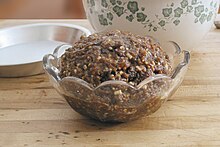Mincemeat
Mincemeat is a mixture of finely chopped dried fruit , brandy and spices , which sometimes also contains beef kidney fat , beef and venison . Originally, meat was always there, which is no longer necessary these days. Some modern recipes call for beef kidney fat, but vegetarians use vegetable shortening instead . Mincemeat can be found in different variations in Great Britain , Ireland , Brittany , Northern Europe , the USA and Canada . 'Mincemeat' is not 'minced meat' ( minced meat to be confused).
Story and variations
English recipes for pies from the 15th, 16th and 17th centuries describe a mixture of meat and fruit, vinegar and wine as a filling , while later in the 18th century spirits - often brandy - were increasingly used. The use of spices such as cloves , nutmegs and cinnamon are typical for meat dishes from the late Middle Ages and the early Renaissance. The sweetness created by the fructose makes mincemeat a less hearty dish and has contributed to its increasing presence among desserts .
A recipe from the 16th century
“Pyes of mutton or beif must be fyne mynced & seasoned with pepper and salte and a lȳtel saffron to color it / suet or marrow a good quantitie / a lȳtel vynegre / pruynes / great reasons / and dates / take the fattest of the broath of powdred beefe. And if you will have paest royall / take butter and yolkes of egges & so to temper the floure to make the paest. "
“ Pie [filling] made from sheep or beef must be finely chopped and seasoned with pepper and salt , and a little saffron to color it. Add a good amount of beef fat or marrow add a little vinegar, prunes , raisins and dates . Use the fattest salted beef broth. And if you want royal baked goods, take butter and egg yolks and mix them with flour to make the dough "
By the mid to late 18th century, mincemeat was increasingly associated with old-fashioned, country, or domestic cuisine. In Victorian England , however, the dish was able to re-establish itself as a recipe for the holidays.
A 19th century recipe from “Mrs. Beeton "
- 2 pounds of raisins
- 3 pounds of currants
- 1 1/2 pounds of lean beef
- 3 pounds of beef kidney fat
- 2 pounds of wet sugar
- 2 ounces of lemon peel
- 2 ounces of candied lemon peel
- 2 ounces candied orange peel
- 1 small nutmeg
- 1 pottle (80 oz.) Of apples
- The zest of two lemons, the juice of one
- 1/2 pint (20 oz.) Brandy
Stone and cut the raisins once or twice, but do not chop them; wash, dry and clean the currants of styles and dirt, and mince the meat and fat, taking care to mince the latter very finely; cut the lemon peel and the candied peels into strips, grate the nutmeg and divide, core and chop the apples; crush the lemon peel, filter the juice and when all the ingredients are prepared mix them well, adding the brandy when the other things are mixed well; push the whole thing into a container, carefully squeezing the air out, and the mincemeat can be used after 14 days.
In the middle of the 20th century, the term was then also used to denote similar mixtures that did not contain meat and in which the animal fats can be wholly or partially replaced by vegetable fats, which then creates a vegetarian variation. However, many recipes still contain venison , chopped sirloin steak , chopped heart, or sometimes ground beef , which is used with raisins, spices, crushed apples, fresh lemon peel and beef fat, currants, candied fruit, lemon peel, and brandy, rum or other spirits . Mincemeat is left to mature, both so that the taste can develop and to give the alcohol time to develop its preservative effect, whereby the texture of the mixture changes over time as the proteins in the meat break down. Preserved mincemeat can be stored for up to ten years.
Mincemeat can be made in the home kitchen and is often made according to family recipes that vary by race and region. Commercial products are usually offered without adding meat. The dish is often eaten as a filling for mince pies or mince tarts during the Christmas season . In the northeastern United States, mincemeat pies are also a traditional Thanksgiving item and are sometimes served with cheddar cheese.
Origin of the term
The word "mince" in Mincemeat comes from the words mincen in Middle English and mincier in Old French , both of which can be traced back to minutiare in Vulgar Latin and minutia in Latin , which denotes smallness. The word mincemeat is an adaptation of the older term minced meat , which describes very finely chopped meat. Meat is historically used not only for meat from animals, but also as a general term for food.
swell
- Marion Cunningham, Jeri Laber: The Fannie Farmer Cookbook . 12th edition. Alfred A. Knopf, New York NY 1979, ISBN 0-394-40650-8 .
- Kenneth F. Kiple, Kriemhild Coneè Ornelas (Ed.): The Cambridge World History of Food . 2 volumes. Cambridge University Press, Cambridge et al. 2000, ISBN 0-521-40216-6 .
Individual evidence
- ^ Isabella Beeton: Book of Household Management. SO Beeton, London 1861: recipe 1309; similar recipes "Lemon Mincemeat (1293)" or "Excellent Mincemeat (1310)"
